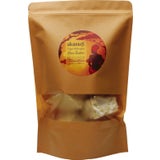Shea Butter - A Blessing For the Skin!
In Europe, Shea Butter is found in many cosmetic products due to its superior skin care properties. Most of our shea butter is produced by hand in Africa. Shea Butter is much more than just a skin care product.
There are few products that are better for the skin than shea butter but few know the origin of this potent skin care product. Shea butter is extracted from the fruit of the shea tree with laborious manual work.
The tree grows in tropical Africa from Senegal to Uganda, giving this area the nickname of the "Shea Belt". Here women remove the valuable butter from the seeds of the trees' fruits. The trees themselves grow wild. Lots of effort is required to extract the butter.
How is shea butter produced?
First, the fruits of the shea tree are manually collected and hung up to dry. After being heated, the seeds sun dried, the shells are removed and the seeds are crushed.
Now the actual production of the butter starts. Once the kernels are dried, they are roasted over a fire. The length of time that they are roasted influences the colour of the butter in the finished product. From white to yellow to black, lots of colours are possible.
After roasting the seeds are crushed and mixed with water. The resulting mass is kneaded by hand and then pressed manually.
The oils rise to the top of the water and are squeezed out to remove water. They are then slowly boiled to allow extra water to evaporate. Then the still hot butter is filtered using cotton cloths. Once the butter hardens again, it is mostly finished. From there the natural dyes are removed, turning it into an odourless, white butter.
Effects of Shea Butter
In the Shea Belt, the positive characteristics of the fruit have been known for millennia. The therapeutic properties of Shea butter include:
- relaxing stressed, irritated, reddened skin
- soothing
- smoothing rough skin
- highly effective moisturizing properties
In Africa Shea is not only used for skin care. The tree and its products accompany the African people from birth to death. Here are all parts of the tree are used - the leaves, the fruit, the resin, and the bark. The oil is boiled, the resin is often used as a natural adhesive and chewing gum, and the oils are also used to fix and repair cracks in walls. In addition, shea butter is used in traditional African medicine. It is a versatile plant that today often represents the livelihood of the people of Africa.
Regional Support
Today there are many natural cosmetic manufacturers that support women's cooperatives in the Shea Belt. Farfalla is one of these companies. The Swiss company supports cooperatives in Burkina Faso. Part of the revenue is donated to improve the living conditions of local people. They also support projects like the construction of wells or grain mills.
DIY Lip Balm
Pure Shea butter is perfect for homemade natural cosmetics! The firm, scentless butter is ideally suited for a variety of ointments and balms for the care of chapped and dry skin. Here's our recipe for homemade lip balm!
ingredients
- 7 g Shea Butter
- 3 g Jojoba Oil
- 2 g Sea Buckthorn Pulp Oil
- 1 drops of Melissa Balm Essential Oil (10%)
Preparation
- Heat 3 g jojoba oil gently in a glass bowl over a water bath.
- Add 7 g shea butter and carefully melt together
- Do not allow the mixture to get too hot and stir well for a good consistency.
- Allow to cool briefly.
- Finally, stir in 2 g sea buckthorn pulp oil and 1 drop of melissa 10% essential oil.
- Allow to cool in a little tub.
Related products
-
 4.4 (16)
4.4 (16)Savon du Midi Soap with Shea Butter, Lavender (100 g)
- Ideal for all skin types
- Ideal for hands & body
- Paper packaging
£2.40 (£24.00 / kg)Delivery by January 06
-
 4.4 (531)
4.4 (531)Biopark Cosmetics Organic Shea Butter, 250 g
- Ideal for dry skin & dry scalp types
- Suitable for baby's skin
- Absorbs quickly
£11.55 (£46.20 / kg)Delivery by January 06
-

Fleurance Nature Sheabutter Hand Cream, 50 ml
- Suitable for dry, demanding skin
- Moisturises
- Smooth and supple hands
£8.10 (£162.00 / l)Delivery by January 06
-
 4.6 (491)
4.6 (491)Akamuti Organic Virgin Shea Butter, 500 g
- Ideal for dry skin
- Ideal for baby's bottom
- Highly moisturising
£18.35 (£36.70 / kg)Delivery by January 06
Magazine Articles:
Discover Ecco Verde:
-
Great Britain: Free standard delivery from £69.90
-
Free
returns -
Get at least 1 free sample
per order More than 19.350 products


